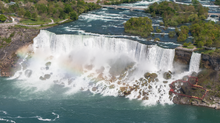Characteristics

The Horseshoe Falls drop about 57 metres (187 ft), while the height of the American Falls varies between 21 and 30 metres (69 and 98 ft) because of the presence of giant boulders at its base. The larger Horseshoe Falls are about 790 metres (2,590 ft) wide, while the American Falls are 320 metres (1,050 ft) wide. The distance between the American extremity of the Niagara Falls and the Canadian extremity is 3,409 feet (1,039 m).
The peak flow over Horseshoe Falls was recorded at 6,400 cubic metres (230,000 cu ft) per second. The average annual flow rate is 2,400 cubic metres (85,000 cu ft) per second. Since the flow is a direct function of the Lake Erie water elevation, it typically peaks in late spring or early summer. During the summer months, at least 2,800 cubic metres (99,000 cu ft) per second of water traverses the falls, some 90% of which goes over the Horseshoe Falls, while the balance is diverted to hydroelectric facilities. This is accomplished by employing a weir – the International Control Dam – with movable gates upstream from the Horseshoe Falls.
The falls' flow is further halved at night, and, during the low tourist season in the winter, remains a minimum of 1,400 cubic metres (49,000 cu ft) per second. Water diversion is regulated by the 1950 Niagara Treaty and is administered by the International Niagara Board of Control (IJC). The verdant green color of the water flowing over the Niagara Falls is a byproduct of the estimated 60 tonnes/minute of dissolved salts and "rock flour" (very finely ground rock) generated by the erosive force of the Niagara River itself.
Comments
Post a Comment